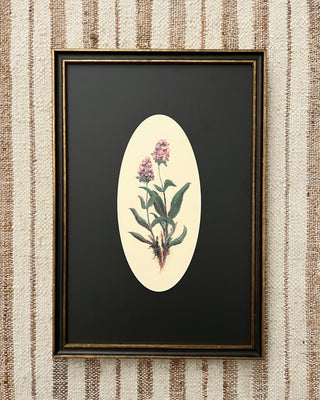Botanicals of the Bible - Spikenard
- Unit price
- /per
"And being in Bethany in the house of Simon the leper, as he sat at meat, there came a woman having an alabaster box of ointment of spikenard very precious; and she brake the box, and poured it on his head."
- Mark 14:3
Like Mary, we are invited to bring our best to the Savior—not just things of material worth, but our spiritual best, as well. Spikenard reminds us that worship is costly—but well worth the price. When we break open our hearts in humble offering, the fragrance of that gift can fill not just a room, but a life.
Printed on 100% cotton rag paper with a velvet (or etching like) surface and matte, low-glare finish. This paper is designed for museum quality, limited edition prints.
Unframed paper prints are shipped rolled or in a rigid envelope.
Framed prints are custom-made with care by our team in Mesa, Arizona. Frames are created without an acrylic or glass covering for a high-end, no-glare finish.
Frame Moulding Dimensions:
8x12 (Bronze & Gold) - Frame Width - 7/8", Frame Depth - 1 3/8"
12x18 (Bronze & Gold) - Frame Width - 7/8", Frame Depth - 1 3/8"
16x24 (Bronze & Gold) - Frame Width - 7/8", Frame Depth - 1 3/8"
Orders for unframed prints typically leave our Mesa, Arizona offices within 3-5 days of purchase.
Framed prints are custom made once ordered and are generally shipped within 10-14 days after purchase. Tracking information will be sent via email once your order is on its way.
Returns are available for unframed print orders for a full refund within 30 days of purchase. Because framed prints are made to order, all sales of framed prints are final, and are not eligible for cancellation or exchange.
*For more information about shipping and returns, please see our FAQ page.
Adding product to your cart
-
ABOUT THE ART
Botanicals of the Bible--Spikenard
By Jenny Komenda
And being in Bethany in the house of Simon the leper, as he sat at meat, there came a woman having an alabaster box of ointment of spikenard very precious; and she brake the box, and poured it on his head.
Mark 14:3
~~~~~~~~~~~~~
In the Gospels, one of the most tender and reverent acts of worship is expressed through a jar of spikenard. Just days before the Savior’s crucifixion, a woman (identified by John as Mary of Bethany) came to Jesus with “an alabaster box of ointment of spikenard very precious,” and then broke the box, anointing the Savior’s head. John records that, following the act, “the house was filled with the fragrance of the ointment.”
Spikenard, derived from the root of a plant native to the Himalayas, was imported at great cost in ancient times. It produced a rich, earthy fragrance and was used in sacred rituals and royal anointings. Spikenard had a unique aroma, the presence of which was an indication that the very best had been offered. Its use symbolized deep love, reverence, and costly devotion.
The anointing of Jesus with spikenard foreshadowed His death and burial, but it also revealed Mary’s understanding of who He truly was—the Messiah. Her worship was personal, sacrificial, and without reservation. Gordon B. Hinckley once observed, “without sacrifice there is no true worship of God.”
Like Mary, we are invited to bring our best to the Savior—not just things of material worth, but our spiritual best, as well. Spikenard reminds us that worship is costly—but well worth the price. When we break open our hearts in humble offering, the fragrance of that gift can fill not just a room, but a life.
Let us not hold back our devotion. As spikenard was poured out by Mary in love, so may our worship be poured out for Him who gave His all for us.
~~~~~~~~~~~~~
ABOUT THE ART
Botanicals of the Bible--Spikenard
By Jenny Komenda
And being in Bethany in the house of Simon the leper, as he sat at meat, there came a woman having an alabaster box of ointment of spikenard very precious; and she brake the box, and poured it on his head.
Mark 14:3
~~~~~~~~~~~~~
In the Gospels, one of the most tender and reverent acts of worship is expressed through a jar of spikenard. Just days before the Savior’s crucifixion, a woman (identified by John as Mary of Bethany) came to Jesus with “an alabaster box of ointment of spikenard very precious,” and then broke the box, anointing the Savior’s head. John records that, following the act, “the house was filled with the fragrance of the ointment.”
Spikenard, derived from the root of a plant native to the Himalayas, was imported at great cost in ancient times. It produced a rich, earthy fragrance and was used in sacred rituals and royal anointings. Spikenard had a unique aroma, the presence of which was an indication that the very best had been offered. Its use symbolized deep love, reverence, and costly devotion.
The anointing of Jesus with spikenard foreshadowed His death and burial, but it also revealed Mary’s understanding of who He truly was—the Messiah. Her worship was personal, sacrificial, and without reservation. Gordon B. Hinckley once observed, “without sacrifice there is no true worship of God.”
Like Mary, we are invited to bring our best to the Savior—not just things of material worth, but our spiritual best, as well. Spikenard reminds us that worship is costly—but well worth the price. When we break open our hearts in humble offering, the fragrance of that gift can fill not just a room, but a life.
Let us not hold back our devotion. As spikenard was poured out by Mary in love, so may our worship be poured out for Him who gave His all for us.
~~~~~~~~~~~~~

you might also like...

OUR WEEKLY PUBLICATION






